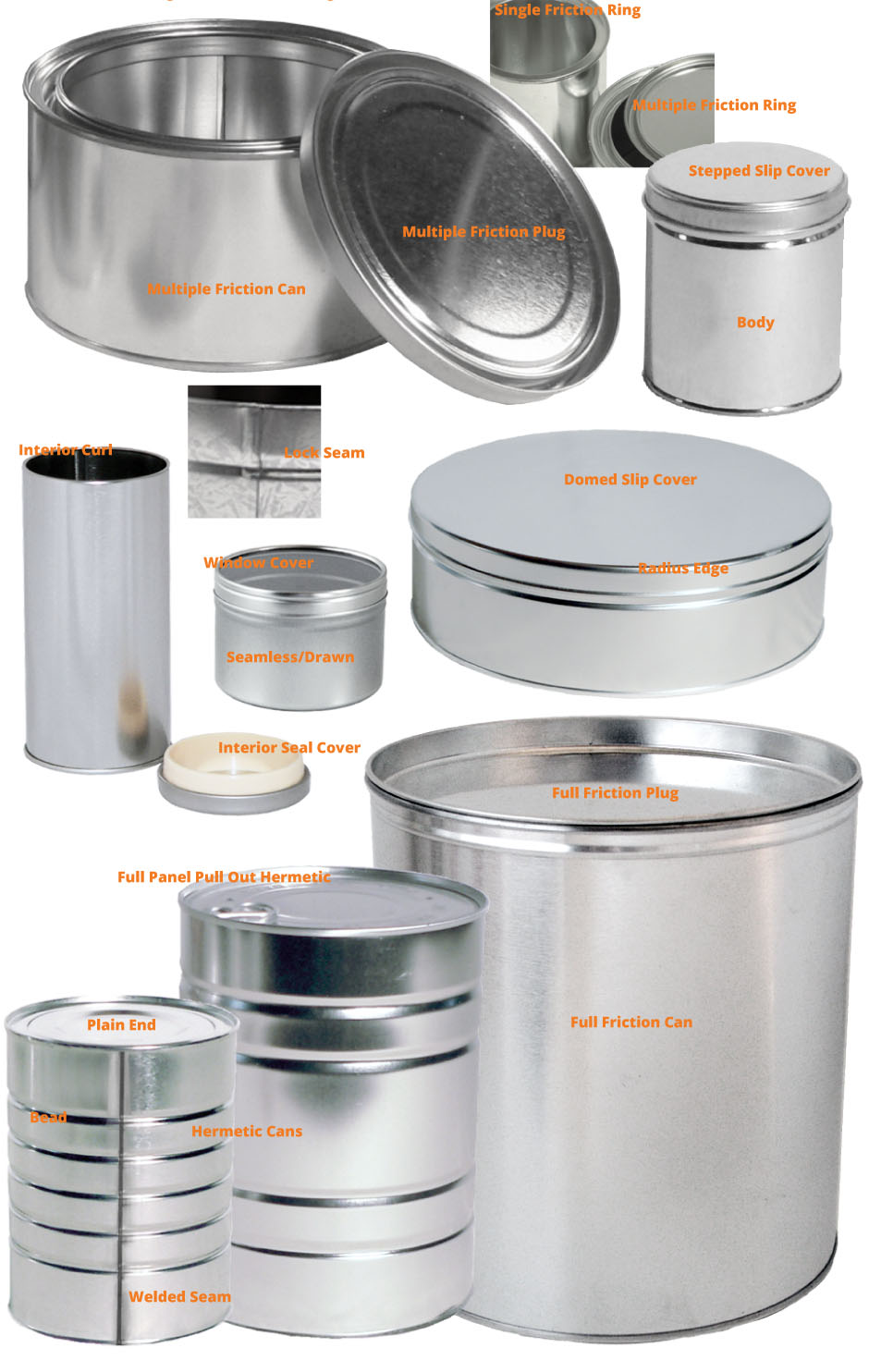Tin Anatomy & Glossary

Tin Terms
Bead: concave (interior bead) or convex (exterior bead) area usually 1/8” wide spanning the circumference of the tin to provide additional strength and stability to the tin body.
Body: a can without a cover (lid); the base of a container.
Cover: a can’s lid or closure.
Curl: area of tin turned in on itself to provide a safe, finished curved edge.
Distortion Printing: printing technique used for making a drawn (seamless) tin in which artwork is intentionally distorted for printing on flat metal. As the seamless tin is drawn upward to form the container, artwork is transformed to its intended representation.
Dome: a type of cover characterized by a flat horizontal surface (top) that tapers smoothly onto the skirt (vertical surface).
Drawn Can: see seamless tin.
End: the area of a tin also known as the bottom. Coffee-style hermetic tins have two ends vs. a cookie-style tin that has an end and a cover. Ends can be attached by seaming them on or crimping using a machine called a seamer.
Four-Color Process: (4/c) the use of four colors: cyan, magenta, yellow and black to produce an almost unlimited spectrum of colors. Artwork is separated to produce four printing plates, one color is printed at a time at differing screen angles to reproduce the original artwork on sheets of flat metal.
Full friction: a plug-style metal cap fits snugly to the interior of the can.
Hem: similar to a curl, an area of tin turned in on itself to provide a safe, finished flattened edge.
Interior Seal: Cover/closure option in which a pliable ring fits to the interior of a tin allowing for a straight-sided slender profile can.
Layout: a two dimensional drawing depicting the exact specifications if a tin in its pre-fabricated (flat) state used for setting artwork up to fit the can.
Lithography: method of printing on flat metal sheets that are later formed into tin cans.
Lock-seam: side walls meet and attach by hooking onto one another to form a tin body. Many decorative tins are fabricated in this manner because this particular seam style allows the printed area to meet at the seam.
Multiple friction: a plug closure fits into a “well” of a seamed on ring. The plug is pressed into the ring and the two surfaces (the outside and inside edge) come into contact with the ring, creating multiple sealing surfaces on the plug/ring combination.
PMS: use of the “Pantone Matching System” for spot colors that either can’t be achieved through 4/c process or is more economical for producing one-, two-, or three- color designs.
Pre-press: preparation of artwork prior to printing; includes setting the artwork up in the proper layout, proofing, making films and plates for printing.
Radius: area on an off round tin where the metal bends to form a “curved corner”; on a cover it is the area where the top surface bends or tapers downward to form the skirt.
Seamless Tin: a tin that is constructed from a single piece of tin drawn to form the body of the can.
Single friction: a plug-style metal cap fits snugly into a seamed on ring. The outside edge of the plug presses against the interior edge of the ring, creating one sealing surface.
Slipcover: cover/closure style in which the cover’s skirt (vertical surface) slips over and to the outside of the can body.
Stepped cover: type of slipcover in which a “step” is created between the horizontal surface and vertical surface of the cover so that stacking tins is possible with less likelihood of toppling over.
Varnish: clear protective coating applied to the metal. Varnish types include gloss, matte, and stipple. We use only FDA approved varnishes safe for food contact.
Welded Seam: seam type in which side walls attach to one another through the use of heat to form a tin body. The seam area can not be printed as printing ink interferes with the strength of the welded area.
White Coat: entire surface of the metal is coated with white before applying other printing ink colors.
White Print: artwork that specifies metallic ink or plain tin in combination with opaque ink requires white prints “sparing out” the areas of plain tin or metallic ink to create a base for printing the opaque inks.
Tin Tips
How to measure a canUsually, heights of cans are measured without covers on in increments of 1/16”. For round cans, diameter is the first listed measurement followed by the height (DxH). Manufacturers use a simplified coding to represent the fraction, for example 301 x 300 is the same as 3-1/16” diameter x 3” high. Fractions can also be reduced, for example 914 diameter is 9-14/16” or 9-7/8”.
Choosing the right metal packagingHundreds of options are available. The type of tin you choose is dictated by what you want to put inside. Styles available include lock-seam, seamless, and welded as well numerous cover and closure alternatives from slipcovers to multi-friction plugs. Don’t be overwhelmed by the possibilities we’ll help guide you through the selection process.
